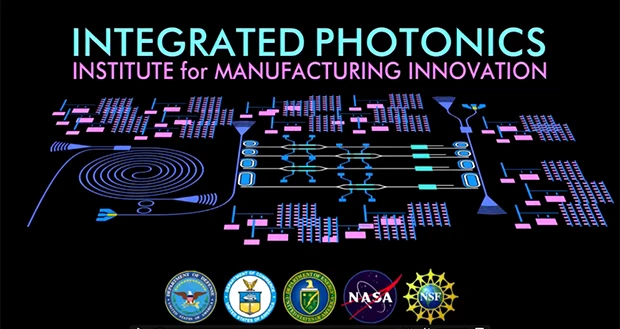
Rochester, New York – Last week, Vice President Biden announced that the Research Foundation for the State University of New York (RF SUNY) will lead a new Manufacturing Innovation Institute to secure U.S. leadership in manufacturing integrated photonics. These emerging technologies have the potential to transform many industries – from creating “needleless” tests for medical conditions like diabetes, to increasing the carrying capacity of broadband communications ten times over.
The Manufacturing Innovation Institute for Integrated Photonics is the sixth of nine such public-private partnerships to boost advanced manufacturing, foster American innovation, and attract and create jobs that strengthen the middle class. After a decade of decline in the 2000s, when 40% of all large factories closed their doors, American manufacturing is adding jobs at its fastest rate in decades, with nearly 900,000 new manufacturing jobs created since February 2010. Manufacturing production is up by almost a third since the recession and the number of factories across the United States is growing for the first time since the 1990s. Today’s new action is the kind of investment we need to build on this progress, creating the foundation for American manufacturing leadership for years to come.
The Department of Defense is awarding the new Manufacturing Innovation Institute for Integrated Photonics to a consortium of 124 companies, nonprofits, and universities led by RF SUNY. With a total investment of over $610 million – $110 million in federal funds, and more than $500 million in non-federal contributions – the announcement marks the largest public-private commitment to date for a manufacturing institute launched in the United States.
Headquartered in Rochester, New York, the long-time home of optical technology pioneer Eastman Kodak, the new Department of Defense led manufacturing institute will help spark new growth in manufacturing building on the area’s legacy of leading optical and photonics technology capabilities – and position the United States for continued leadership in this critical technology area. Already, member companies are demonstrating what is possible atop such foundations - including Harris Corporation, Sydor Optics, and Optimax, which have all recently opened or expanded operations in the region, bringing dynamism to the region’s intrepid photonics cluster. By attracting hundreds of millions of dollars of new investment in photonics, and convening leading photonics capabilities from across the nation in Rochester, the institute will accelerate the growth of this industry in the upstate New York area.
The new photonics institute is the sixth of nine announced as part of the National Network of Manufacturing Institutes (NNMI). From the very first manufacturing institute, pioneering novel 3D printing technologies in Youngstown, Ohio, to the most recently awarded institute pushing the boundaries on advanced materials in Knoxville, Tennessee – each institute is part of a growing network dedicated to securing U.S. leadership in the emerging technologies required to win the next generation of advanced manufacturing.
Bridging the gap between applied research and product development, each institute brings together companies, universities, other academic and training institutions, and Federal agencies to co-invest in key emerging technology areas that can encourage investment and production in the U.S. This latest institute, a new public private partnership led by RF SUNY, will bridge advanced research and commercial product development, yielding critical defense and telecommunications advances – while also investing in education and workforce development to train and position the next generation of manufacturers in integrated photonics.
Just as integrated electronic circuits allowed for advanced processing in computers and cellphones, integrated photonic components can pack even more processing power into a single chip, creating new possibilities for computing and telecommunications. An emerging technology for carrying light-waves, integrated photonics has the potential to revolutionize entire industries—from increasing the carrying capacity of broadband communications ten-fold, to creating needle-free tests for common conditions like diabetes, and to improving imaging capabilities in defense operations.
Vice President Biden is also calling on Congress to make a clear choice: We can make critical bipartisan investments to strengthen manufacturing across the United States, laying a strong foundation for good jobs and economic growth – or we can pull back, letting other countries and their workers take the lead. The President’s Fiscal Year 2016 Budget would strengthen America’s leadership in advanced manufacturing, providing the resources to grow the NNMI to 16 institutes by the end of 2016 (with a goal of up to 45 institutes over a decade). In contrast, the House and Senate funding bills would entrench harmful "sequester" levels of funding, putting critical investments in advanced manufacturing, workforce development and training, and innovation at risk.
Background on the Integrated Photonics Institute for Manufacturing Innovation Institute:
The new institute the Department of Defense is awarding today will focus on cutting-edge research in integrated photonics – using multiple units of light, on a single platform, to improve the performance and reliability of telecommunications, radar, lasers, and other technologies.
Photonics is the science of using and controlling photons – the smallest unit of light – to convey information and images. By shrinking electronic components like lasers and optical sensors to a scale hundreds of times smaller than a single living cell – and putting these components on a single platform – integrated photonics could advance technology in ways never before possible, including by:
- Revolutionizing long-haul telecommunications, enabling much more resilient fiber with much greater bandwidth
- Creating dramatic energy savings at high-performing data centers, which across the country now consume almost as much power each year as the entire state of New York.
- Dramatically improving medical technology – from “needleless” technologies for monitoring blood sugar levels, to cameras smaller than pills that travel within arteries, to substantially faster and lower-cost human genome sequencing.
- Improving security operations, with applications in radar, electronic warfare, imaging, sensing, and communication systems used across the entire spectrum of land, air, sea, and space-based platforms.
Integrated photonics is a type of microelectronics, a set of technologies that has powered decades of American economic growth. Investing in scalable photonics manufacturing is critical to meeting our technology and economic needs in the decades ahead. The market for integrated photonics is growing rapidly. But many manufacturers – especially small businesses – have inadequate capital to penetrate it. The new institute will focus on bringing these technologies down the cost curve, letting American companies lead in their development.
The Integrated Photonics Institute for Manufacturing Innovation will work to develop lower-cost, higher-speed, and more efficient manufacturing processes for photonic circuits, by:
- Developing an end-to-end photonics ‘ecosystem’ in the U.S., including domestic foundry access, integrated design tools, automated packaging, assembly and testing, and workforce development.
- Creating a standardized platform currently lacking in the integrated photonics space, making it easier to scale the technology across multiple markets and drive performance, cost, and scaling requirements.
- Assembling a world-class team of organizations from across the photonics industry, including leading manufacturers, material suppliers and software developers, government and academia.
- Pairing photonics companies (like Analog Photonics, Juniper Networks, and OptiPro) with key end users of integrated circuits (like Northrop Grumman for defense imagery and Hewlett Packard for high performance computing) and top research universities (like the University of Rochester, with its pioneering integrated circuitry labs, and the California Institute of Technology, with advanced lithography testing).
The winning team, led by the Research Foundation of the State University of New York (RF SUNY) and headquartered in Rochester, NY, includes the following 75 key partners and 49 additional consortia members:
55 Companies: 4D Technologies, Acacia Communications, Analog Photonics, Aurrion, Boeing, Cadence Design, Chiral Photonics, Corning, Freedom Photonics, GE, Harris Corp., Hewlett Packard, Infinera, Intel, IQE, Juniper Networks, Keysight, Lockheed Martin, Mentor Graphics, Nistica, Northrop Grumman, Samtech, Synopsys, TE Connectivity, United Technologies, Adarza Biosystems, Advanced Glass Ind., ANSI, Axsun Technologies, FiconTEC, Honeywell, IBM, Imaging Solutions Grp., LGS Innovations, Lumerical, Micron, Morton Photonics, Navitar, New Scale Tech., Optimax, OptiPro, Patent Innovations, PhoeniX Software, Photon Gear, Promex Industries, Raytheon, Rockwell Collins, RPC Photonics, Seagate, SRI, Sydor Optics, Syntec Optics, TeraDiode, Texas Instruments, Vincent Associates.
20 Universities and Laboratories: Boston University, California Institute of Technology, Columbia University, Massachusetts Institute of Technology, Rochester Institute of Technology, Stanford University, State University of New York, University of Arizona, University of California Berkeley, University of California Davis, University of California San Diego, University of California Santa Barbra, University of Colorado-Boulder, University of Delaware, University of Rochester, University of Virginia, Alfred University, Binghamton University, Drexel University, and Pennsylvania State University.
33 Community Colleges and Other Schools: NEW YORK: Adirondack Community College, Broome Community College, Cayuga Community College, Clinton Community College, Columbia-Greene Community College, Corning Community College, Dutchess Community College, Erie Community College, Fashion Institute of Technology, Finger Lakes Community College, Fulton-Montgomery Community College, Genesee Community College, Herkimer County Community College, Hudson Valley Community College, Jamestown Community College, Jefferson Community College, Mohawk Valley Community College, Monroe Community College, Nassau Community College, Niagara County Community College, North Country Community College, Onondaga Community College, Orange County Community College, Rockland Community College, Schenectady County Community College, Suffolk County Community College, Sullivan County Community College, Tompkins Cortland Community College, Ulster County Community College, Westchester Community College. CALIFORNIA: Allan Hancock Community College, Santa Barbara Community College, and Ventura College. MASSACHUSETTS: Quinsigamond Community College.
16 Non-Profit Organizations: Catalyst Connection, Draper Laboratory, Institute for Energy Efficiency, The Manufacturing Institute, Massachusetts Manufacturing Extension Partnership (MassMEP), MESA, NEATECH, New York Photonics, Empire State Developments Division of Science, Technology and Innovation (NYSTAR), OP-TECH, Optical Society of America (OSA), PSMC, SEMATECH, SEMI, SPIE, and the University of California Santa Barbara (UCSB) Technology Management Program.
20 States: New York, California, Massachusetts, Arizona, New Jersey, Florida, Colorado, Maryland, Pennsylvania, Missouri, Indiana, Delaware, Virginia, Minnesota, Idaho, Texas, Washington, Iowa, Connecticut, and Oregon.
Source: White House
Latest from Today's Medical Developments
- The toolbelt generation
- Covestro's role in transforming cardiac care
- Practical and Affordable Factory Digital Twins for SMEs
- UCIMU: fourth quarter 2024 machine tool orders on the rise
- Thomson Industries’ enhanced configuration capabilities
- Frequently Asked Questions about AM Post Processing
- How new executive orders may affect US FDA medical device operations
- Midwest DISCOVER MORE WITH MAZAK





